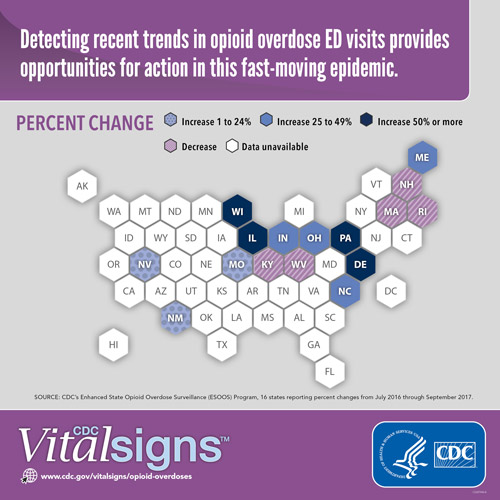Emergency Department Data Show Rapid Increases in Opioid Overdoses
Wake-up call to the fast-moving opioid overdose epidemic
Press Release
Embargoed Until: Tuesday, March 6, 2018, 1:00 p.m. ET
Contact: Media Relations
(404) 639-3286
Data from emergency departments (EDs) show that the U.S. opioid overdose epidemic continues to worsen, according to the latest Vital Signs report by the Centers for Disease Control and Prevention (CDC).
The report examines the timeliest data available to CDC on ED visits for opioid overdoses across multiple states. Overall, ED visits (reported by 52 jurisdictions in 45 states) for suspected opioid overdoses increased 30 percent in the U.S., from July 2016 through September 2017. Opioid overdoses increased for men and women, all age groups, and all regions, but varied by state, with rural/urban differences. The findings highlight the need for enhanced prevention and treatment efforts in EDs and for greater access to evidence-based opioid use disorder treatments, including medication-assisted treatment and harm reduction services.
“Long before we receive data from death certificates, emergency department data can point to alarming increases in opioid overdoses,” said CDC Acting Director Anne Schuchat, M.D. “This fast-moving epidemic affects both men and women, and people of every age. It does not respect state or county lines and is still increasing in every region in the United States.”
ED data allow faster tracking of regional and state trends
Data from 16 states in CDC’s Enhanced State Opioid Overdose Surveillance (ESOOS) Program were analyzed, showing quarterly trends by state and rural/urban differences from July 2016 through September 2017. Overall, ED visits for suspected opioid overdoses increased 35 percent in these 16 states hit hard by the epidemic. The data show:
- Eight states from three U.S. regions reporting substantial increases—25 percent or greater—in the rate of opioid overdose ED visits.
- Significant increases in all states reporting in the Midwest, including Wisconsin (109 percent), Illinois (66 percent), Indiana (35 percent), Ohio (28 percent), and Missouri (21 percent).
- Considerable variation among states in the Northeast and Southeast; some states reported substantial increases and others modest decreases:
- In the Northeast, large increases were seen in Delaware (105 percent), Pennsylvania (81 percent), and Maine (34 percent), but other states, like Massachusetts, New Hampshire, and Rhode Island showed nonsignificant decreases (<10 percent).
- In the Southeast, North Carolina reported an increase (31 percent), while Kentucky reported a statistically significant decrease (15 percent).
- Continued rises in cities and towns of all types. Highest rate increases (54 percent) were in large central metropolitan areas (a population of 1 million or more and covering a principal city).
The sharp increases and variation across states and counties indicate the need for better coordination to address overdose outbreaks spreading across county and state borders. Closer coordination between public health and public safety agencies can support identification of changes in supply and use of illicit opioids, further allowing communities to take appropriate action to reduce opioid overdoses.
CDC also examined data from the National Syndromic Surveillance Program (NSSP) BioSense platform, using ESSENCE (Electronic Surveillance System for the Early Notification of Community-based Epidemics) software. Analysis of data from 52 jurisdictions in 45 states, which covers over 60 percent of ED visits in the U.S., found that from July 2016 through September 2017:
- All five U.S. regions experienced rate increases; the largest was in the Midwest (70 percent), followed by the West (40 percent), Northeast (21 percent), Southwest (20 percent), and Southeast (14 percent).
- Every demographic group experienced substantial rate increases, including men (30 percent) and women (24 percent) and people ages 25-34 (31 percent), 35-54 (36 percent), and 55 or older (32 percent).
The report noted the central role of state and local health departments in coordinating responses to opioid overdoses. Health departments can:
- Alert communities to rapid increases in overdoses seen in EDs and coordinate an informed and timely response.
- Increase naloxone distribution (an overdose-reversing drug) to first responders, family and friends, and other community members in affected areas, as policies permit.
- Increase availability of and access to treatment services, including mental health services and medication-assisted treatment for opioid use disorder.
- Support programs that reduce harms which can occur when injecting opioids, including those that offer screening for HIV and hepatitis B and C, in combination with referral to treatment.
- Support the use of the CDC Guideline for Prescribing Opioids for Chronic Pain, which encourages using prescription drug monitoring programs (PDMPs) to inform clinical practice.
“Research shows that people who have had an overdose are more likely to have another. Emergency department education and post-overdose protocols, including providing naloxone and linking people to treatment, are critical needs,” said Alana Vivolo-Kantor, Ph.D., behavioral scientist in CDC’s National Center for Injury Prevention and Control. “Data on opioid overdoses treated in emergency departments can inform timely, strategic, and coordinated response efforts in the community as well.”
A companion editorial “Opportunities for Prevention and Intervention of Opioid Overdose in the Emergency Department,” was also released today in Annals of Emergency Medicine.
On March 13, 2018 (2-3:30 pm ET), CDC will host a webinar “Coordinating Clinical and Public Health Responses to Opioid Overdoses Treated in Emergency Departments,” featuring the U.S. Surgeon General, Acting CDC Director, CDC Vital Signs MMWR author, and experts from Rhode Island.
For more information about opioid overdose and prevention, please visit www.cdc.gov/drugoverdose.
Vital Signs is a CDC report that typically appears on the first Tuesday of the month as part of the CDC journal Morbidity and Mortality Weekly Report. The report provides the latest data and information on key health indicators.
###
U.S. DEPARTMENT OF HEALTH AND HUMAN SERVICES
CDC works 24/7 protecting America’s health, safety and security. Whether disease start at home or abroad, are curable or preventable, chronic or acute, or from human activity or deliberate attack, CDC responds to America’s most pressing health threats. CDC is headquartered in Atlanta and has experts located throughout the United States and the world.

